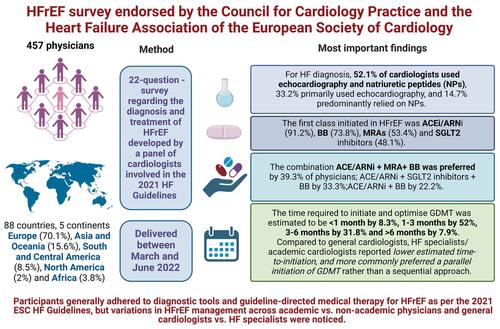当前位置:
X-MOL 学术
›
Eur. J. Heart Fail.
›
论文详情
Our official English website, www.x-mol.net, welcomes your
feedback! (Note: you will need to create a separate account there.)
Translating the 2021 ESC heart failure guideline recommendations in daily practice: Results from a heart failure survey. A scientific statement of the ESC Council for Cardiology Practice and the Heart Failure Association of the ESC
European Journal of Heart Failure ( IF 16.9 ) Pub Date : 2024-09-25 , DOI: 10.1002/ejhf.3444 Ruxandra Christodorescu, Oliviana Geavlete, Marc Ferrini, Thomas Kümler, Konstantinos Toutoutzas, Antoni Bayes‐Genis, Petar Seferovic, Marco Metra, Ovidiu Chioncel, Giuseppe M.C. Rosano, Gianluigi Savarese
European Journal of Heart Failure ( IF 16.9 ) Pub Date : 2024-09-25 , DOI: 10.1002/ejhf.3444 Ruxandra Christodorescu, Oliviana Geavlete, Marc Ferrini, Thomas Kümler, Konstantinos Toutoutzas, Antoni Bayes‐Genis, Petar Seferovic, Marco Metra, Ovidiu Chioncel, Giuseppe M.C. Rosano, Gianluigi Savarese

|
AimsReal‐world data show that guidelines are insufficiently implemented, and particularly guideline‐directed medical therapies (GDMT) are underused in patients with heart failure and reduced ejection fraction (HFrEF) in clinical practice. The Council for Cardiology Practice and the Heart Failure Association of the European Society of Cardiology (ESC) developed a survey aiming to (i) evaluate the perspectives of the cardiology community on the 2021 ESC heart failure (HF) guidelines, (ii) pinpoint disparities in disease management, and (iii) propose strategies to enhance adherence to HF guidelines.Methods and resultsA 22‐question survey regarding the diagnosis and treatment of HFrEF was delivered between March and June 2022. Of 457 physicians, 54% were general cardiologists, 19.4% were HF specialists, 18.9% other cardiac specialists, and 7.7% non‐cardiac specialists. For diagnosis, 52.1% employed echocardiography and natriuretic peptides (NPs), 33.2% primarily used echocardiography, and 14.7% predominantly relied on NPs. The first drug class initiated in HFrEF was angiotensin‐converting enzyme inhibitors/angiotensin receptor–neprilysin inhibitor (ACEi/ARNi) (91.2%), beta‐blockers (BB) (73.8%), mineralocorticoid receptor antagonists (MRAs) (53.4%), and sodium–glucose cotransporter 2 (SGLT2) inhibitors (48.1%). The combination ACEi/ARNi + MRA+ BB was preferred by 39.3% of physicians, ACEi/ARNi + SGLT2 inhibitors + BB by 33.3%, and ACEi/ARNi + BB by 22.2%. The time required to initiate and optimize GDMT was estimated to be <1 month by 8.3%, 1–3 months by 52%, 3–6 months by 31.8%, and >6 months by 7.9%. Compared to general cardiologists, HF specialists/academic cardiologists reported lower estimated time‐to‐initiation, and more commonly preferred a parallel initiation of GDMT rather than a sequential approach.ConclusionParticipants generally followed diagnostic and treatment guidelines, but variations in HFrEF management across care settings or HF specialties were noted. The survey may raise awareness and promote standardized HF care.
中文翻译:

将 2021 年 ESC 心力衰竭指南建议转化为日常实践:心力衰竭调查结果。 ESC 心脏病学实践委员会和 ESC 心力衰竭协会的科学声明
目标真实世界数据显示,指南实施不充分,特别是临床实践中心力衰竭和射血分数降低 (HFrEF) 患者中指南导向的药物治疗 (GDMT) 未得到充分利用。心脏病学实践委员会和欧洲心脏病学会 (ESC) 心力衰竭协会开展了一项调查,旨在 (i) 评估心脏病学界对 2021 年 ESC 心力衰竭 (HF) 指南的看法,(ii) 查明差异方法和结果 2022 年 3 月至 6 月期间进行了一项关于 HFrEF 诊断和治疗的 22 个问题调查。在 457 名医生中,54% 是普通心脏病专家,19.4 % 是心力衰竭专家,18.9% 是其他心脏专家,7.7% 是非心脏专家。对于诊断,52.1% 使用超声心动图和利钠肽 (NP),33.2% 主要使用超声心动图,14.7% 主要依赖 NP。 HFrEF 中启动的第一个药物类别是血管紧张素转换酶抑制剂/血管紧张素受体脑啡肽酶抑制剂 (ACEi/ARNi) (91.2%)、β 受体阻滞剂 (BB) (73.8%)、盐皮质激素受体拮抗剂 (MRA) (53.4%)和钠-葡萄糖协同转运蛋白 2 (SGLT2) 抑制剂 (48.1%)。 39.3% 的医生首选 ACEi/ARNi + MRA+ BB 组合,33.3% 的医生首选 ACEi/ARNi + SGLT2 抑制剂 + BB,22.2% 的医生首选 ACEi/ARNi + BB。启动和优化 GDMT 所需的时间预计为 <1 个月,缩短 8.3%,1-3 个月,缩短 52%,3-6 个月,缩短 31.8%,>6 个月,缩短 7.9%。 与普通心脏病专家相比,心力衰竭专家/学术心脏病专家报告的估计启动时间较短,并且更常见地更喜欢并行启动 GDMT,而不是顺序方法。 结论 参与者通常遵循诊断和治疗指南,但不同护理环境中的 HFrEF 管理存在差异或高频专业被注意到。该调查可能会提高人们的认识并促进标准化心力衰竭护理。
更新日期:2024-09-25
中文翻译:

将 2021 年 ESC 心力衰竭指南建议转化为日常实践:心力衰竭调查结果。 ESC 心脏病学实践委员会和 ESC 心力衰竭协会的科学声明
目标真实世界数据显示,指南实施不充分,特别是临床实践中心力衰竭和射血分数降低 (HFrEF) 患者中指南导向的药物治疗 (GDMT) 未得到充分利用。心脏病学实践委员会和欧洲心脏病学会 (ESC) 心力衰竭协会开展了一项调查,旨在 (i) 评估心脏病学界对 2021 年 ESC 心力衰竭 (HF) 指南的看法,(ii) 查明差异方法和结果 2022 年 3 月至 6 月期间进行了一项关于 HFrEF 诊断和治疗的 22 个问题调查。在 457 名医生中,54% 是普通心脏病专家,19.4 % 是心力衰竭专家,18.9% 是其他心脏专家,7.7% 是非心脏专家。对于诊断,52.1% 使用超声心动图和利钠肽 (NP),33.2% 主要使用超声心动图,14.7% 主要依赖 NP。 HFrEF 中启动的第一个药物类别是血管紧张素转换酶抑制剂/血管紧张素受体脑啡肽酶抑制剂 (ACEi/ARNi) (91.2%)、β 受体阻滞剂 (BB) (73.8%)、盐皮质激素受体拮抗剂 (MRA) (53.4%)和钠-葡萄糖协同转运蛋白 2 (SGLT2) 抑制剂 (48.1%)。 39.3% 的医生首选 ACEi/ARNi + MRA+ BB 组合,33.3% 的医生首选 ACEi/ARNi + SGLT2 抑制剂 + BB,22.2% 的医生首选 ACEi/ARNi + BB。启动和优化 GDMT 所需的时间预计为 <1 个月,缩短 8.3%,1-3 个月,缩短 52%,3-6 个月,缩短 31.8%,>6 个月,缩短 7.9%。 与普通心脏病专家相比,心力衰竭专家/学术心脏病专家报告的估计启动时间较短,并且更常见地更喜欢并行启动 GDMT,而不是顺序方法。 结论 参与者通常遵循诊断和治疗指南,但不同护理环境中的 HFrEF 管理存在差异或高频专业被注意到。该调查可能会提高人们的认识并促进标准化心力衰竭护理。


















































 京公网安备 11010802027423号
京公网安备 11010802027423号